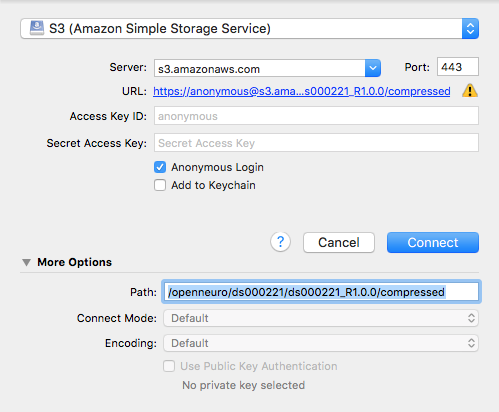Overview
The participants included in this dataset (n = 321) participated in one or two protocols. Each of these protocols included structural and resting-state fMRI data acquisition.
This dataset includes the available modalities:
- FLAIR
- T1map
- T1w
- defacemask
- bold
- T2w
- dwi
- fieldmap
Anatomical, functional, and resting state scan parameters from the scanner console are available in German. For scan parameters in English, please see the dataset descriptor paper.
Experimental Protocol
Participants were instructed to remain awake with their eyes open and to fixate on a low-contrast crosshair on grey background.
While in the scanner, and immediately after each of the four-resting state runs, participants received the computerized version of the short version of the New York Cognition Questionnaire.
Reference: Ruby, F. J., Smallwood, J., Engen, H. & Singer, T. How self-generated thought shapes mood—the relation between mind-wandering and mood depends on the socio-temporal content of thoughts. PloS One 8, e77554 (2013).
Data Release Download
Data for the Mind-Brain-Body dataset are available for download in an Amazon Web Services S3 bucket.
Each file in the S3 bucket can only be accessed using HTTP (i.e., no ftp or scp ). You can obtain a URL for each desired file and then download it using an HTTP client such as a web browser, wget, or curl. Each file can only be accessed using its literal name - wildcards (i.e. "*") will not work.
There are file transfer programs that can handle S3 natively and will allow you to navigate through the data using a file browser. Cyberduck is one such program that works with Windows and Mac OS X. Cyberduck also has a command line version that works with Windows, Mac OS X, and Linux. Instructions for using the Cyberduck program are as follows:
- Open Cyberduck and click on Open Connection.
- Set the application protocol in the dropdown menu to S3 (Amazon Simple Storage Service).
- Set the server to s3.amazonaws.com.
- Check the box labelled Anonymous Login.
- Expand the More Options tab and set Path to openneuro/ds000221/ds000221_R1.0.0/compressed.
- Click Connect.

Personnel
- Arno Villringer
- Anahit Babayan
- Michael Gaebler
- Lina Schaare
- Josefin Röbbig
- Miray Erbey
- Andrea Reiter
- Janis Reichelt
- Deniz Kumral
- Natacha Mendes
- Sabine Oligschläger
- Mark E. Lauckner
- Johannes Golchert
- Julia M. Huntenburg
- Marcel Falkiewicz
- Sarah Krause
- Blazej M. Baczkowski
- Roberto Cozatl
- Maria Dreyer
- Haakon Engen
- Nicolas Farrugia
- Laura Golz
- Krzysztof J. Gorgolewski
- Philipp Haueis
- Rebecca Jost
- Yelyzaveta Kramarenko
- Katharina Ohrnberger
- Anastasia Osoianu
- Jared Pool
- Jonathan Smallwood
- Daniel S. Margulies
Contact
Daniel Margulies: margulies@cbs.mpg.de
Marcel Falkiewicz: mfalkiewicz@cbs.mpg.de
Publications using the Mind-Brain-Body Dataset
- Dataset Descriptor Paper: Mendes, N., Oligschlaeger, S., Lauckner, M. E., Golchert, J., Huntenburg, J. M., Falkiewicz, M., ... & Osoianu, A. (2017). A functional connectome phenotyping dataset including cognitive state and personality measures. bioRxiv, 164764.
- Golchert, J., Smallwood, J., Jefferies, E., Seli, P., Huntenburg, J.M., Liem, F., Lauckner, M.E., Oligschläger, S., Bernhardt, C.B., Villringer, A., Margulies, D.S. (2017). Individual variation in intentionality in the mind-wandering state is reflected in the integration of the default-mode, fronto-parietal, and limbic networks. NeuroImage, 146, 226-235.
- Golchert, J., Smallwood, J., Jefferies, E., Liem, F., Huntenburg, J.M., Falkiewicz, M., Lauckner, M.E., Oligschläger, S., Villringer, A., Margulies, D.S. (2017). In need of constraint: Understanding the role of the cingulate cortex in the impulsive mind. NeuroImage, 146, 804-813.
- Oligschläger, S., Huntenburg, J.M., Golchert, J., Lauckner, M.E., Bonnen, T.R., Margulies, D.S. (2016). Gradients of connectivity distance are anchored in primary cortex. Brain Struct Funct, 1-10.
Data Sharing License
Acknowledgments
We thank Shameem Wagner and Elizabeth Kelly for assistance in the preparation of the manuscript.
Grants
AR was supported by BMBF EMOTISK 16SV7243 and German Research Foundation SFB 940/2 B7
JS and DSM were supported by Volkswagen Foundation (Wandering Minds – 89440)
JS was supported by ERC (WANDERINGMINDS - 646927), Volkswagen Foundation (Wandering Minds - 89439) and the John Templeton Foundation, “Prospective Psychology Stage 2: A Research Competition”.

